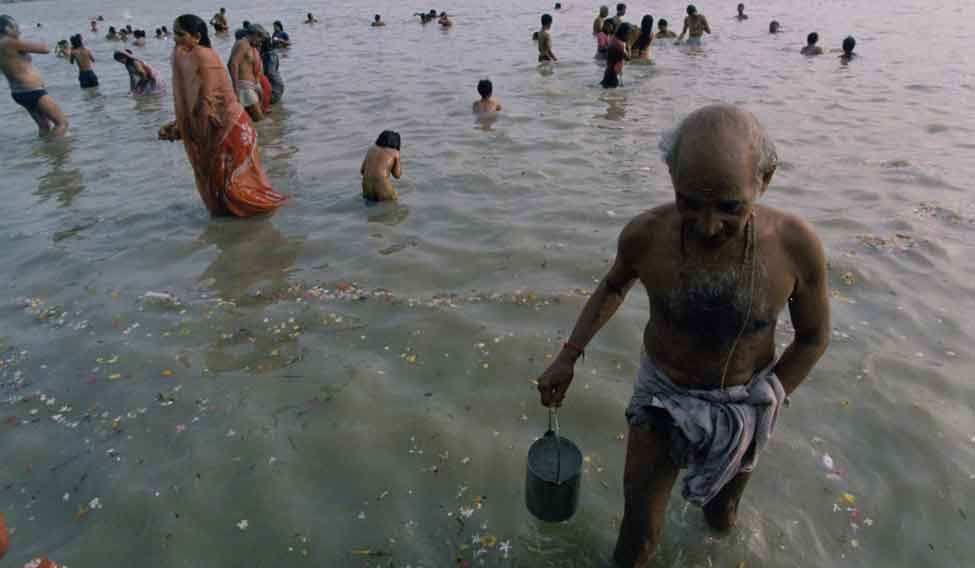The Sarayu flows quietly, unmindful of the summer sun that at its height scorches man, beast and tree. The heat wave in Uttar Pradesh has consumed 38 lives.
It is early morning. The bathing ghat near the disputed land in Ayodhya is humming with activity: mantras rent the air, men and women wade into the water for a dip in the faint light. The sadhus, their wet behinds visible through transparent clothes, move on to the disputed land, their kamandals full. Inside poky little tents on the banks priests sit in front of fire and heaps of offerings from pilgrims paying homage to their dead.
The Ayodhya-Gouda highway near the ghat is crammed with tourist vehicles. A narrow bridge across a lake leads to one temple complex. lnside, it's life of a bygone era, the Ayodhya of yore. Pandits with tufts of hair on balding pates, and women and children with flower baskets lend it the innocence it lost.
Several young men wave at our Omni shouting, “Bhai-saab. stop. Guide hai....” A determined 16-year-old boy runs after us as we enter a narrow street leading to the disputed site. We stop for him. “Sunil Pandey. Guide,”‘he gasps, getting into the Omni. He is one of the 500-odd guides employed by the Hindu organisations. The going is good, says Pandey. “Sometimes I even get Rs 200 a day.”
We stop our vehicle six metres from the disputed land. As we walk past a 10-foot high wall, and the old buildings behind it, Pandey points to the idols of minor gods in newly sprung up shacks along the street. He persuades us to put money in the hundis there. Next stop, at his insistence, is a VHP office, where again the main business is collection for the temple.
We encounter the first road block 200 metres from the VHP office. Frisking over, a policeman warns me not to use the camera inside the complex. Further ahead there are two more road blocks, manned by the paramilitary. An officer informs us that we can leave our bags at an old VHP office nearby.
We leave everything except wallets and pens. They have fixed a rate for safekeeping, Rs 2 for a camera and so on. We move on, negotiating the barricades. Another 200 metres and yet another check-post: here we have to leave behind the pens as well. The makeshift Ram temple is just 100 metres away.
What catches the eye first is a huge mound of earth upon which a canopied shed made of cloth. Ram Lalla is inside. Pujas are on. The priests distribute prasad. The long line of devotees does not seem to move an inch even after an hour. We walk past a horde of swamis, their potlis (cloth bundles) tied to a long staff on their shoulders. We reclaim our belongings, and Pandey leads us to the Hanuman Mandir near Karsevakpuram.
Bang opposite the mandir is a two-storey building, where Nritya Gopaldas meditates. He was the last priest of the Ram Janmabhoomi temple before the Babri Masjid was demolished. Now he is deputy chief of Ram Janmabhoomi Nyas.
Near by is a model of the proposed Ramachandra Bhagwan Complex on the disputed land, exhibited in a glass case. Here, too, VHP activists collect contributions from visitors, sometimes forcibly. To anyone who cares to listen they explain that they feed and house about 2,000 swamis in Ayodhya.
A kilometre away is a 10—acre plot, walled on all sides. It is Ram Janmabhoomi Mandir Nirman Karyalay. Behind the signboard, gods look down from a 25-foot-high detachable marble door. Inside the enclosure 15 sculptors are working on 1,000-odd pillars, 5 to 10 metres long. The pillars are too large for two persons to encircle with their arms, and can be joined together to form a huge one. The overseer Nagendra Upadhaya says most of the 60 skilled workers from Udaipur are absent because it is Amavasi (new moon). But there are not many holidays.
At the Karyalay there is a sandalwood model of the temple in a five-foot glass case. A few women light lamps in front of an idol of the snake god near by and circle a pipal tree. its leaves rustling high above. A troop of monkeys trot around a heap of half-finished marble slabs.
We turn back, leaving the sculptors to their hammer and chisel. We turn back, having seen the fallout of an event that changed lndian politics and culture. And probably the buildup of another event that could be equally cataclysmic.





